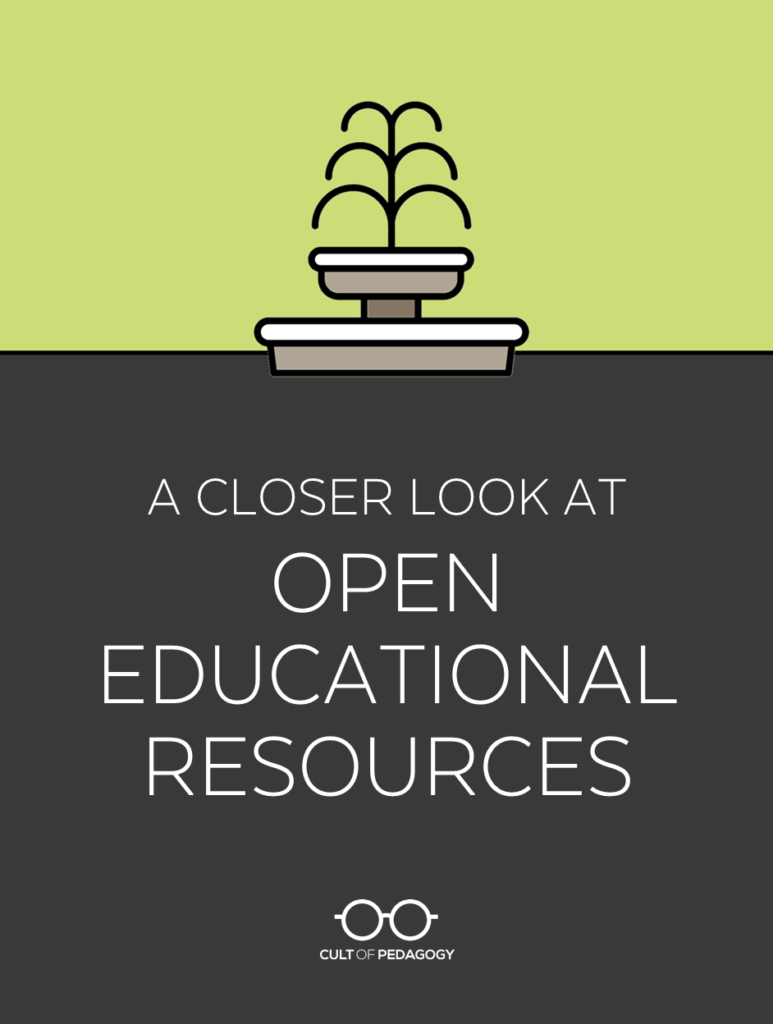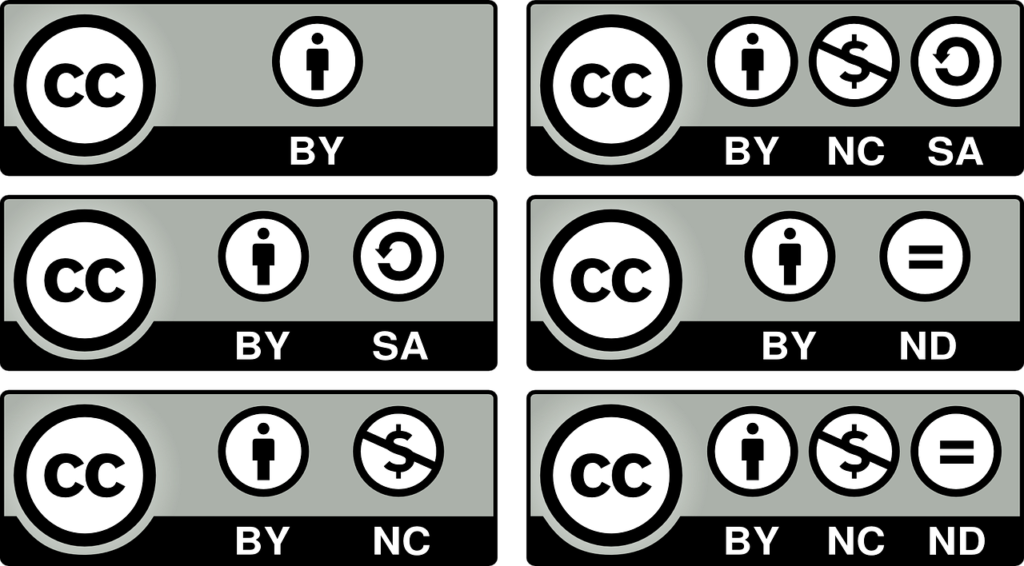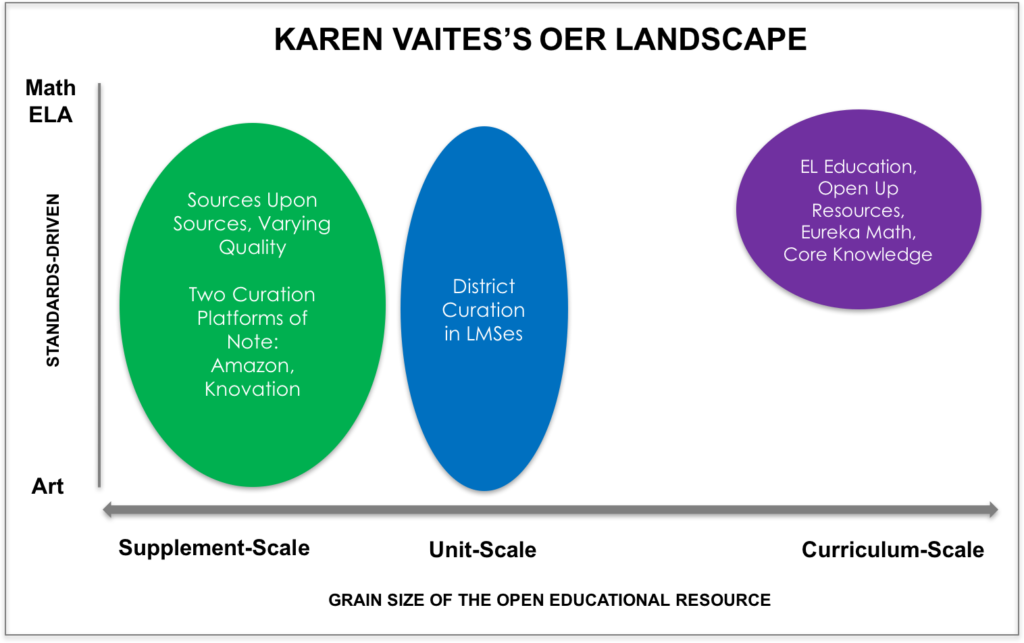
Listen to my interview with Karen Vaites (transcript):
Sponsored by Pear Deck and Chill Expeditions
For as long as the internet has been around, teachers have been able to find free resources online. But while it’s great to not have to pay for things, free instructional materials don’t exactly come without problems.
One major concern is quality. When a resource is free, it’s often hard to tell whether it was created by someone with a solid education background or if it’s going to be really effective in teaching what you want to teach. It’s also quite possible that the resource wasn’t properly proofread and contains errors both in mechanics and in content.
Another issue is copyright. Just because a resource can be downloaded without a fee doesn’t mean you have permission to use or share it. Digital resources, including those that cost money, can easily be distributed online with just a few clicks, and once a stolen resource is “out there,” it can be difficult to get it taken down.
Finally, there’s the problem of cohesiveness. Grabbing one-off materials from various sources can help you satisfy immediate instructional needs, and variety is a good thing, but if you’re looking for something more robust, more sustainable, you’ll have a harder time finding it without paying for it.
With these problems in mind, I was skeptical when I first heard about the #GoOpen movement. This initiative, launched by the U.S. Department of Education in 2015, encouraged schools and districts to adopt free, openly licensed instructional resources. Sounded nice in theory, but I didn’t see it working: Where was the quality control? How would teachers be able to tell if they were getting good stuff? In a crowded sea of free resources, how many hours would it take to even find what they needed?
Then, earlier this year, I went to a conference and met Karen Vaites, who calls herself a “curriculum evangelist” and is an enthusiastic promoter of OERs, Open Educational Resources. Talking to Karen over cheeseburgers at one of the diviest bars in Austin, I was convinced to give OERs another look.

In our podcast interview, which you can listen to above, Karen and I talk about how OERs have gotten really, really good over the last few years, what some new platforms are doing to solve the quality problem, and where teachers can go to find outstanding materials—from single-use resources to full-year curricula—that are 100% free.
What are Open Educational Resources?
The U.S. Department of Education defines OERs as “teaching, learning, and research resources that reside in the public domain or have been released under a license that permits their free use, reuse, modification, and sharing with others. Digital openly licensed resources can include complete online courses, modular digital textbooks as well as more granular resources such as images, videos, and assessment items.”
So unlike materials that your school needs to purchase from a publishing company or independent seller, OERs are completely free.
Vaites cautions teachers to pay attention to licensing when looking for OERs. “All things that are OER are given away for free,” she says, “but all things that are free are not OER, so if you go to Pinterest or Teachers Pay Teachers and you find a free resource, that resource may not actually give you the permission to edit and modify as you see fit.”
True OERs will be marked with a Creative Commons license, which gives users permission to use the resource for free. There are six different levels of licenses, each of which comes with its own restrictions. The licenses are pictured below and more details are available about each one at the Creative Commons website.

Why Should Teachers Pay Attention to Open Resources Now?
Free resources have always been around, but over the last 10 years or so, they have gotten a lot better and more comprehensive.
Vaites explains the whole spectrum of available OERs with a graph, where the X-axis represents the size of the resource.
“On the left side of that continuum you have supplement-scale materials: everything from a math practice item to a poem to one lesson. On the right you have curriculum-scale materials: teacher and student materials for a full grade band for a full year, complete with scope and sequence, and usually with assessments.”

The Y-axis would represent how aligned those resources are with specific standards. Some subject areas, like ELA and math, are held more tightly to specific standards, while others, like art, have fewer specific requirements.
Over the last few years, that top right quadrant has grown. “A big shift is this movement from there not only being lots and lots of open resources that were available that were maybe smaller in grain size—more like supplements—to us actually having OER curricula,” Vaites says.
And many of the newer resources are excellent. “We see a lot of intentionality around creating a more student-centered, hands-on, active learning instructional model.”
How Can Teachers Steer Clear of Free “Junk”?
Despite the existence of outstanding materials, the task of finding them in a sea of potentially low-quality resources can still be overwhelming. What can busy teachers do to make sure they are finding the best free resources out there?
When it comes to the smaller, one-off resources—the supplement side of the continuum—where “it’s still a bit of everything,” Vaites says educators mostly have to rely on user ratings.
“You can definitely find some things (on Amazon Inspire, for example) that have a pile of high star ratings, and just like anything else when you’re searching on Amazon, that can be a really useful proxy for quality. But you also don’t know who gave those star ratings, and did they give it because they liked the design or because it’s instructionally nutritious?”
“It’s a lot easier on the curriculum side of the continuum,” she says, “because we have organizations that do third-party reviews, all created by teams of educators.”
One of these organizations is EdReports, a nonprofit that puts together teams of educators to review full curricula. “They put out reviews of all kinds of programs,” Vaites says, “whether you’re looking at OERs or even commercial products, they’re just a wonderful resource to separate the good from the just OK to the not so great.”
Where to Find the Best Open Resources
Platforms with supplement-scale resources that are rated or curated:
- Amazon Inspire
- Knovation (curated resources within a paid platform)
Curriculum-Scale Open Educational Resources:
Available today and highly-rated by EdReports:
- EL Education Language Arts – and check out the modEL Detroit companion resources created by Detroit Public Schools
- Core Knowledge Language Arts
- Eureka Math
- Open Up Resources Math
Eagerly-anticipated curricula, for which strong reviews are anticipated:
- MVP Math (integrated math approach) – solid version 1 available today, enhanced version soon to be published as OER
- Bookworms K–5 Reading & Writing – version 1 in many schools today, enhanced version soon to be published as OER
- Illustrative Mathematics High School and Elementary Math
Additional Options
Core Knowledge History and Geography and Science Curricula
Join our mailing list and get weekly tips, tools, and inspiration that will make your teaching more effective and fun. You’ll get access to our members-only library of free downloads, including 20 Ways to Cut Your Grading Time in Half, the e-booklet that has helped thousands of teachers save time on grading. Over 50,000 teachers have already joined—come on in.





I have been using Openstax for over ten years now, the fact that you are just now promoting it is completely abhorrent. Your students should not be spending $200-$500 for a text book ever, when there are so many free resources available. Professors who say they can’t find great free resources for their students to use are lazy,
cheating their students, and should not be teaching period.
You’re right, Sanford! OER’s have been around for a long time. In the post, Jenn does talk a great deal about why she was pretty skeptical of OERs for such a long time and then what led her to take another look. The post doesn’t really address open textbooks at the college level – it’s good to know that you’ve been able to access quality resources for your students. If you go to this comment, you’ll find recommendations for other textbook OERs that you might want to check out.
Sanford: Not everyone has been teaching for ten years. So. even if they had promoted sites you have used for ten years, i think its nice to mention those sites now. We are all at different places in the journey.
I’ve just signed up to enroll in the July technology course offered. Super excited to learn all of the various aspects that will enhance my ELA instruction and how my student’s learning will be positively impacted! Awesome means to differentiation & my hope is to sincerely become a 21st century educator after 26 years in the classroom!!!
Hi Barbara!
Wow! 26 years! We are excited to have you in the July course. Looking forward to learning with and from you.
Time to take another look at MVP math. It has been a nightmare of a curriculum in Wake Country, NC. 16 parents filed formal complaints about it, local high school kids walked out in protest of MVP math, hundreds of parents have complained to MVP, our school board, our Dept of Ed but we get no help. We are teaching our kids at home at night or paying got tutors. Our county has spent well over $1 million dollars implementing this FREE program. And what does our begging and pleading for help get us? MVP has sued a local Dad for speaking out against them. One claim they cited as slander is hyperbole but they are a math curriculum not english so I can understand their mistake. And they recently put out a statement called Correcting the Record to show their view point. They got their say in the law suit. The defendant gets to Correct the Record. (MVP has since changed the title of their statement)
Perhaps they thought a lawsuit would shut the parent up but instead it organized the parents, united us since many thought it was just a problem with our kid and the sued parent has countersued.
https://www.wral.com/wake-parent-countersues-mvp-math-after-company-sues-him-for-libel-and-slander/18626794/?version=amp
And if you want another example check out Modesto, CA’s experience with MVP math.
I am aware that some parents have expressed concerns about the MVP Math curriculum in Wake County (NC). As this commenter states, 16 parents shared complaints with the district. Approximately 88,000 students in the district use the MVP Curriculum. (Wake is one of the largest districts in the US, with around 160,000 students.) This context seems important in considering the scale of the concerns.
Based on the comments of these parents on blogs and in social media, they seem to have concerns that the curriculum places too much emphasis on learning of math concepts, as opposed to procedural work in mathematics.
North Carolina standards call for a balance of conceptual and procedural math work. Most educators I know are looking to support that kind of balance in math classrooms, and use curricula that support the Five Practices, etc., while also supporting procedural practice and fluency.
I would point readers to the resources below if they want to learn more about the materials and the specific context in Wake County.
1. EdReports, the review site I mentioned in the podcast: EdReports reviews of MVP Math (which has two versions, one for traditional math and one for integrated) offer an independent review of the quality of the materials and alignment to standards.
EdReports review of MVP Math (integrated):
https://edreports.org/reports/overview/mathematics-vision-project-mvp-integrated-2016
EdReports review of MVP Math (traditional): https://edreports.org/reports/overview/mathematics-vision-project-mvp-traditional
2. Statement from MVP Math regarding its work in Wake County, which provides some additional color on their materials, as well as the lawsuit referenced by the commenter:
https://www.mathematicsvisionproject.org/clarifications-regarding-our-work.html
To clarify one point you made and MVP likes to use without full context is this. Only 16 parents went through the lengthy and time consuming process of filing Formal complaints. Most didn’t even know that was an option. Most parents have sent emails, made calls and spoken in person to the school board, the schools, the state board of Ed, supt. of schools, teachers and governor begging for this MVP program to end. The High School that walked out in protest has 3000+ students. So saying only 16 complained is a lie and everyone knows it. Our county is huge so getting complaints organized and connected has been tough so they tried to say it was isolated problems. It’s not. They wanted to keep us isolated but we figured it out thanks to social media.
So before one more person uses the statement only 16 out of 88000 complained go count the emails, calls, conferences, speakers at school board meetings, ppl interviewed on news reports, parent/teacher conferences specifically about MVP math and takk to math totrs on the increased demand for tutors then get back to us. Also keep in mind we are all legitimately afraid speaking out will get us sued too! Think about that. Fear of speaking out on behalf of your kids ’cause you could get sued by a curriculum creator. That is education today. Some Teachers have felt pressure from the county to play nice as well. It’s down right bizarre.
To top that off new numbers were just revealed showing the data presented by the county was spun badly. Our math scores are down -7% to -19% depending which report you view. When presented with this our school board and MVP went silent.
MVP Common Core 2.0 doesn’t work. Common Core 1.0 wasn’t great either. A middle ground must be reached. Textbooks without constant errors like MVP worksheets are important. And group think fails a lot of kids.
Love so much about this post. I’ve use many of these resources within my previous middle school classroom. Question: any suggestions on places like those above for high school teachers? Now that I teach high school, I’ve found it increasingly difficult to find equitable and useful resources.
Yes! I love https://www.matchfishtank.org/ for resources K-12. They have some great things and are open to feedback.
Lindsay,
I completely agree. I have spent some time after listening to this podcast looking for resources in a science high school classroom. I feel like there is a lot of resources for elementary and content wise the math/ELA realms. I was hoping to see more options for high school.
We use PhET simulations a LOT in our school
Our school district is a national OER leader. We recently had 4 content teams present at the National #GoOpen Summit in San Diego. I don’t share to brag, but more to give clout to what is to follow. I believe in the power of transparent instructional practices inclusive of resources. The more we share what, how and why we do what we do, the more we can grow as educators to better meet the needs of ALL learners. OER offers transparent educational resources. As with any new resource adoption, OER is no different in that there are hiccups along the way that a team will encounter. There is a lot of hoop jumping. Any well-versed district in OER will hand over a lengthy list of rules/processes for a team to adhere to (such as copyright, creative commons, do’s/don’ts for supplemental resources…). However, one major hurdle our team found was getting started. There was no template from which to build upon. Essentially, a team is given a blank canvas with rules of do’s and don’ts, but no direction as to how to piece it all together. And so I circle back to transparent practices. Your post reminds me of the importance of OER teams tweeting, blogging, podcasting, and in short, sharing their templates. While there is no one-size-fits-all template, if each OER team shares HOW they went about piecing it all together, then teams new to OER will have more than a blank canvas with which to build upon. As always, thank you for another thought-provoking podcast!
One thing that’s not mentioned in the blog or in the podcast are the many open textbooks out there, started by college professors in protest to the insanely high prices of textbooks. These can be found at https://libretexts.org/, the University of Minnesota (https://open.umn.edu/opentextbooks/), and, more broadly, the Open Textbook Network: https://research.cehd.umn.edu/otn/membership-benefits/network-members/
Free science sources are actually pretty widespread, and predate NGSS. Some others include PhET, at University of Colorado, and outreach from ACS.
This is great. Can’t wait to sift through the information and let my staff know.
Do any of you have any high-quality resources for high school science, especially the life science?
Yes! I went through the links and I’m not seeing much Earth Science or Environmental Science for the high school level. If you know of any resources, I’d love if anyone has any OER for those!
SO……if one were teaching for a large district with an espensive adoption that is not nearly as good as one of these OER’s what advice would you have for pushing back and using an OER curriculum instead?
Regarding the comment whether a professional would share their work “out of the goodness of their heart”…. Yes, there are indeed many quality educators who share their work freely in an effort to up the bar. The OCLC says it well… “Because what is known must be shared”
Hi!
I read Cult of Pedagogy posts every week. Thank you for this high-quality source of professional development!
I have a minor point of feedback that is not specific to this post. When you add links to your posts, it would be helpful if you chose the “Open in a new tab” setting. Currently, when I click on a link, the browser simply takes me to that other website, and then I have to navigate back to your website if I want to continue reading the article. I would imagine that the “Open in a new tab” would also be beneficial to your web views, as people would remember to return and keep reading. Just a thought!
Otherwise, please keep doing what you’re doing.
Thanks,
Jessica
Hey Jessica, thanks for the comment. Jenn used to set up links so that they would open in a new tab. However, more and more websites are trending towards having links open in the same tab. If you prefer opening the link in a new tab, you always have the option of hitting the “ctrl” key while clicking the link. I hope that helps!
Thank you for that little tech nugget. I was wondering the same thing.
I have been interested in OERs for a while. I have tried LearnZillion before and loved it. I am happy to see Amazon has gotten on board. Thank you for posting your vetted list. I am interested in trying out the Bookworms K-5 site as well!
This is, by far, my favorite podcast and it’s value is something I share with anyone who will listen. However it was really troubling to me, and I had to go back and listen several times to make sure I was hearing it right, that Vaites says, “I am unaware of any state that has an arts standard”. With the title of Curriculum Evangelist I can’t image she is unaware that nearly every state has a comprehensive set of arts standards, many recently-revised based on the National Core Arts Standards that we’re widely celebrated when they came out four years ago. I am hoping I just misunderstood her because that statement made me question her credibility in the remaining minutes of the episode.
I appreciate all the thought-provoking work that the Cult of Pedagogy team is doing every day!
Thank you for the comment! You make a good point – I had real unfinished learning about Art standards, and a few folks pointed that out to me after the podcast. I’ve been squarely focused on math and literacy in recent years, and for whatever reason, while math and ELA standards are constantly topical in my work, art standards never seem to come up. I’m reflecting on that, and schooling myself now.
Nice post, and yes you’re right how can we know if a post that is uploaded as free is legit or not. OERs is great step in such but can they moderate all of their free content is a big question.
Would something like Big History Project fall at least partially under this label?
Hi Liz,
We would definitely say that the BHP falls into the category of OER. This article takes a look at how they’ve moved along the horizontal line Jenn writes about in the post, towards a more “curriculum-scale” OER: This Tech Helps Turn OER Into Cohesive Curriculum.
Some news for folks using /seeking / building OERs: https://www.edsurge.com/news/2019-11-01-open-up-resources-takes-a-digital-leap-through-kiddom-partnership
Hello all;
I am a retired Business Teacher and Education Computer Strategist; now returning to teaching in Nevada. Online Education Resources have changed drastically since I retired In 2013. The only ones that I used were the programs and articles that came with the publication or text books. One question: Has anyone ever performed a Fry readability graph on the units they are selecting? That activity would be a great feature, and not take very long to do.
That’s a great question. As this article states, it’s important to consider both readability and author’s craft when evaluating texts, as readability does not account for figurative language, style, or even conceptual content. However, for teachers out there who might be interested in performing a Fry readability graph, here’s a website that can do it for you.